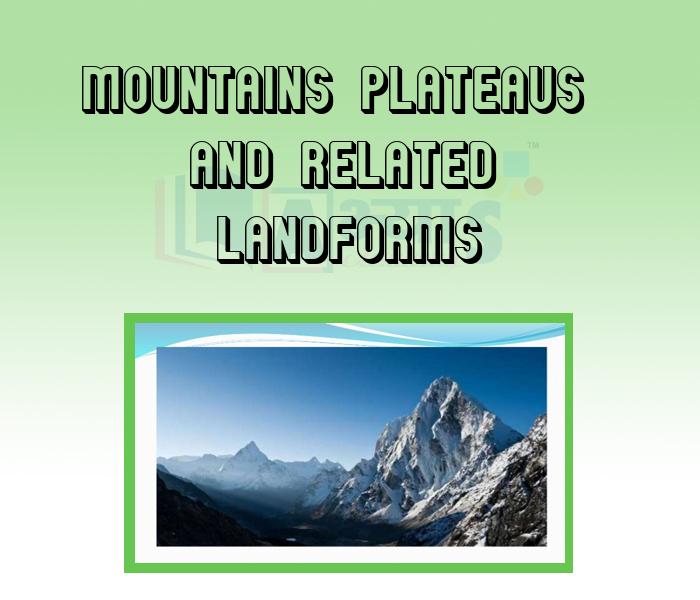Mountains Plateaus And Related Landforms









Mountains Plateaus And Related Landforms
Land Forms: Our earth consists of oceans and continents. The measure of land area on the carth surface is called Landmass. Land covers 29.2% of the surface area of our earth, and waters (oceans) cover approximately 7o.8% of it. Landmass includes continents and islands. There are three major types of Land forms found on the earth's surface - Mountains, Plains and Plateaus.
Mountain, Plateaus and Related Land forms: Vertical earth movements can cause the crust to warp and sometimes large areas of it are uplifted whilst others are depressed. The uplifted areas form plateaus, sometimes called tectonic plateaus, and the depressed areas form basins. There are two types of tectonic plateaus. Some slope down to surrounding lower land e.g. the Deccan Plateau of India. Other plateaus slope up to surrounding mountains and these are called inter-mountain plateaus. The Tibetan and Bolivian plateaus are the examples.
Rift valley is linear-shaped lowland between highlands or mountain ranges created by the action of a geologic rift or fault. This action is manifested as crustal extension, a spreading apart of the surface, which Subsequently further deepened by the forces of erosion. When the tensional forces are strong enough to the plate to split apart, it will do so such as a centre block will drop down relative to its flanking, forming a graben. This creates the nearly parallel steeply dipping walls. This feature is the beginning of the rift valley. As this process continues, the valley gets wider and wider until it becomes a large basin that fills with sediment from the rift walls and the surrounding area. Examples of Rift Valleys: East African Rift and the Baikal Rift Zone, which are currently active, and the West Antarctic Rift.
Top 10 Tallest Mountains
Mount Everest 8,848m (29,029ft) Nepal/China
Qogir (K2) 8,611 m (28,250 ft) Pakistan
Kangchenjunga 8,586 m (28,169 ft) Nepal
Lhotse 8,501 m (27,920 ft) Nepal
Makalu I 8,462 m (27,765 ft) Nepal
Cho Oyu 8,201 m (26,906 ft) Nepal
Dhaulagiri 8,167 m (26,794 ft) Nepal
Manaslu I 8,156 m (26,758 ft) Nepal
Nanga Parbat 8,125 m (26,658 ft) Pakistan
Annapurna I 8,091 m (26,545 ft) Nepal
The dormant volcano Mauna Kea (on the Big Island of Hawaii) could be considered the tallest mountain in the world . If you measure it from its base in the Hawaiian Trough (3,300 fathoms deep) to its summit of 13,796 feet, it reaches a height of 33,476 feet.
Tallest mountains
(In Each Continent)
Mount Everest 8,848 m (29,029 ft) Asia
Aconcagua 6,959 m (22,831 ft) S. America
Mount McKinley 6,194 m (20,320 ft) N. America
Mount Kilimanjaro 5,963 m (19,563 ft) Africa
Mount Elbrus 5,633 m (18,481 ft) Europe
Puncak Jaya 4,884 m (16,023 ft) Oceania
Vinson Massif 4,897 m (16,066 ft) Antartica
Students / Parents Reviews [10]
A marvelous experience with Abhyas. I am glad to share that my ward has achieved more than enough at the Ambala ABHYAS centre. Years have passed on and more and more he has gained. May the centre flourish and develop day by day by the grace of God.

Archit Segal
7thMy experience was very good with Abhyas academy. I am studying here from 6th class and I am satisfied by its results in my life. I improved a lot here ahead of school syllabus.

Ayan Ghosh
8thAbhyas Methodology is very good. It is based on according to student and each child manages accordingly to its properly. Methodology has improved the abilities of students to shine them in future.

Manish Kumar
10thOne of the best institutes to develope a child interest in studies.Provides SST and English knowledge also unlike other institutes. Teachers are co operative and friendly online tests andPPT develope practical knowledge also.

Aman Kumar Shrivastava
10thMy experience with Abhyas academy is very good. I did not think that my every subject coming here will be so strong. The main thing is that the online tests had made me learn here more things.

Hiya Gupta
8thBeing a parent, I saw my daughter improvement in her studies by seeing a good result in all day to day compititive exam TMO, NSO, IEO etc and as well as studies. I have got a fruitful result from my daughter.

Prisha Gupta
8thMy experience with Abhyas is very good. I have learnt many things here like vedic maths and reasoning also. Teachers here first take our doubts and then there are assignments to verify our weak points.

Shivam Rana
7thAbout Abhyas metholodology the teachers are very nice and hardworking toward students.The Centre Head Mrs Anu Sethi is also a brilliant teacher.Abhyas has taught me how to overcome problems and has always taken my doubts and suppoeted me.

Shreya Shrivastava
8thIt was a good experience with Abhyas Academy. I even faced problems in starting but slowly and steadily overcomed. Especially reasoning classes helped me a lot.

Cheshta
10thI have spent a wonderful time in Abhyas academy. It has made my reasoning more apt, English more stronger and Maths an interesting subject for me. It has given me a habbit of self studying
